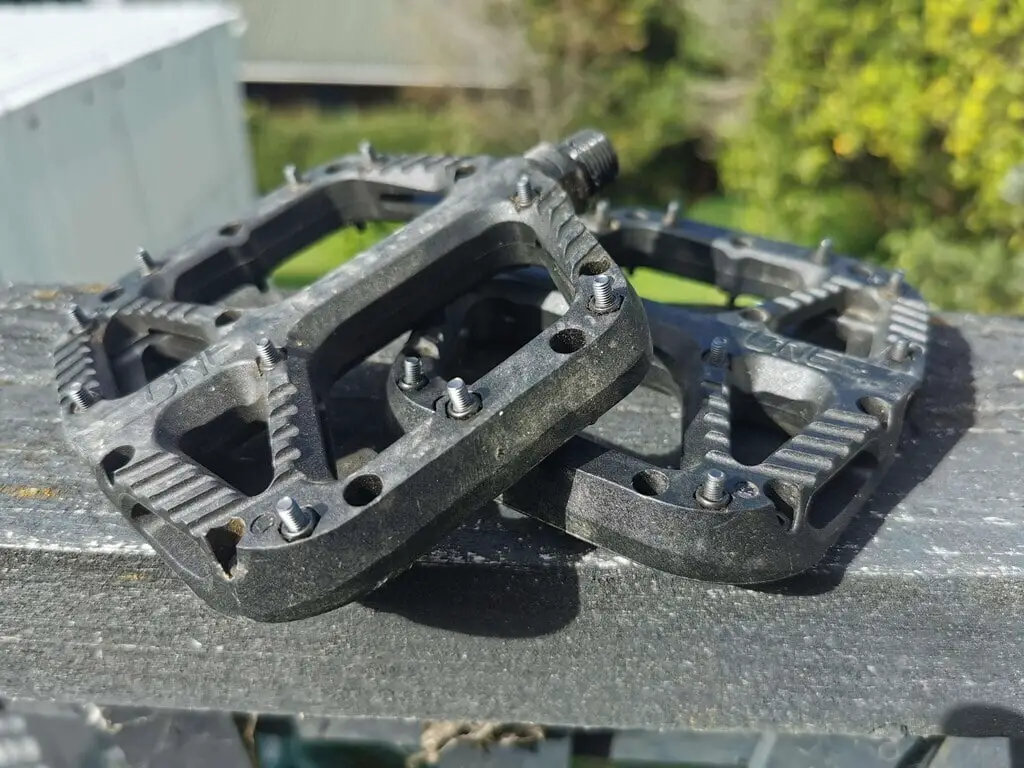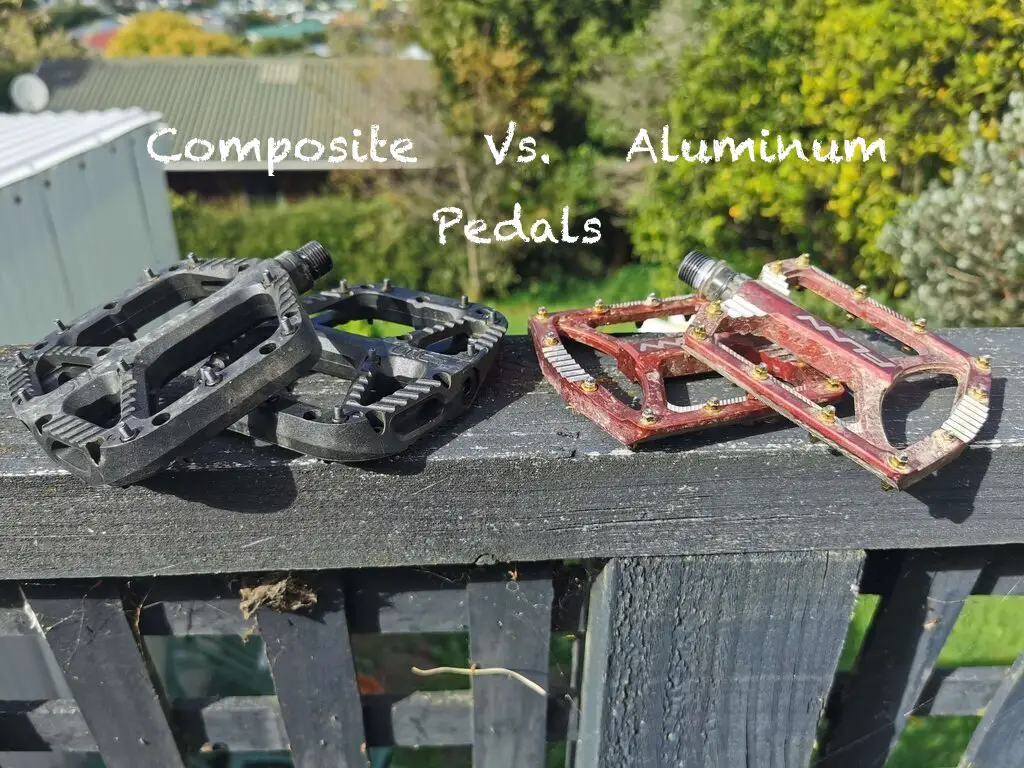So you’re looking into a new set of flat mountain bike pedals, and wondering, what actually is the difference between composite and aluminum pedals? Are composite pedals too good to be true?
All that and more is answered here as we take an in-depth look into both composite and alloy pedals and which one is right for you.
Composite Pedals

Composite pedals, often known as ‘plastic’ pedals, have taken off in recent years thanks to huge developments in composite compound technology. These days, the top-end composite pedals are made from a nylon composite compound far from the plastic feel you might be thinking of.
The great thing about this is that you can’t feel any flex in the pedal, and the days of non-durable plastic pedals are gone. We’ll get into the details of composite pedals below so you can make the most informed decision about what pedals to purchase.
Types of Composite Pedals
First of all, let’s get stuck into the types of composite pedals and which ones you should avoid and why.
All Plastic Unsealed Bearings
Stay clear of these pedals. Although they’re cheap, there’s a reason. They’re not suitable for mountain biking and won’t last long at all!
I would refer to these as the old-school ‘composite’ pedals as they are the cheap-feeling pedals that are made using a simple plastic mold. They are probably the pedals you had as a kid. With recent developments, I would consider them just that, a kids’ bike pedal.
They won’t hold up to any off-road riding, and the bearings are usually unsealed, meaning they won’t last long, and they’re definitely not replaceable!
Premium Composite Pedals
Now, these are the pedals that excite us at MTBGearBox! In a nutshell, they are durable pedals, with premium bearings and as much grip as alloy pedals for a fraction of the cost. You really have to feel them to understand.
The nylon composite compound just feels extremely solid, much like aluminum for that matter. They also have metal adjustable and replaceable pins for grip, so there are no worries there.
Many of these composite pedals are a copy of a brand’s alloy pedals, and so they feature the same premium serviceable bearings. Take OneUp Components, for example; they have both the alloy version of the flat pedal and the composite version. The only difference being the material the platform is made of and the price.
In summary, the premium composite pedals are a much more affordable version of a premium alloy pedal, with the only difference being the material. They are a great way to get an excellent pedal for a fraction of the price.
Composite Pros
- First is the price! You can get an excellent pedal for a fraction of the cost of an aluminum pedal.
- Lightweight
- All one color, so no obvious scratch marks
Composite Cons
- Thickness, the pedals are a bit thicker than alloy pedals
- Looks, there’s no arguing that alloy pedals look better
Aluminum Pedals

Aluminum pedals, more often referred to as ‘alloy’ pedals, have been many riders’ go-to pedals. Thanks to their great looks and premium feel. Alloy pedals have also improved significantly in recent years. A heap of work has gone into the traction pins’ shape and placement. They’re considerably better than the old bear trap pedals that everyone used to use.
Types of Aluminum Pedals
Just like composite pedals, there are good and bad alloy pedals. The old school bear trap pedals come under the bad, and the new pedals from the likes of OneUp and Crankbrothers are good.
Budget Moulded Pedals
These are the pedals that look like the ones pictured above. Back in the day, they were super popular. Still, in comparison to today, they are ancient and the technology is much much better.
One issue with them is that they have minimal grip, and there is almost no grip in the wet. The molded grooves just don’t have the traction like modern pins.
Also, they are very heavy and don’t have the premium bearings that come with most other mountain bike pedals. This is crazy, considering they are a similar price to the top-level composite pedals.
Premium Alloy Pedals
The top alloy pedals these days are awesome! And look great. They are CNC machined and have adjustable/replaceable traction pins.
Aluminum pedals are much thinner than composite pedals thanks to the stronger material, which means fewer rock strikes! Although a few millimeters may not seem like too much, it sure is when you are constantly riding close to rocks and other obstacles.
The other thing you can’t look past is the looks. They are much better looking than composite pedals. For many riders, this is what pulls them over from composite pedals. All I can say is if you have the budget, then fair enough.
In summary, alloy pedals are both much thinner and better looking than composite pedals. They often feature the same platform shape and pins except for the thickness. In my opinion, if you have a higher budget, then go for the aluminum, but for most people, composite pedals will do the job just as well for a fraction of the cost.
Alloy Pros
- They look great
- Thinner than composite pedals
Alloy Cons
- More expensive
Composite Vs. Aluminum Pedals Summary
So, to wrap this all up, the short answer is that composite pedals are almost as good as aluminum pedals, with the exception of the looks and thickness. What this means is that you can get an excellent pedal for a fraction of the cost.
Many people say that composite pedals are not as durable. However, I don’t believe that is the case. From my experiences, I believe that a good set of composite pedals will last just as long as a set of alloy pedals. This is with the exception of hard hits to the pedal, but I mean big hits as composite pedals won’t take the blunt force as well as alloy. They would be slightly more prone to cracking, but they are certainly not fragile.
Conclusion
In conclusion, if you want a great set of pedals on a budget, then go with the composite pedals. They are great value, provide tons of grip, and will last you years if looked after properly.
If you have a larger budget and want a thinner better-looking pedal, then go with alloy. Alloy pedals definitely have that more premium look and feel, so if you have the money, why not get yourself a set of stunning alloy flat pedals.
If you’re wanting to know more about flat MTB pedals, check out our in-depth guide here.


